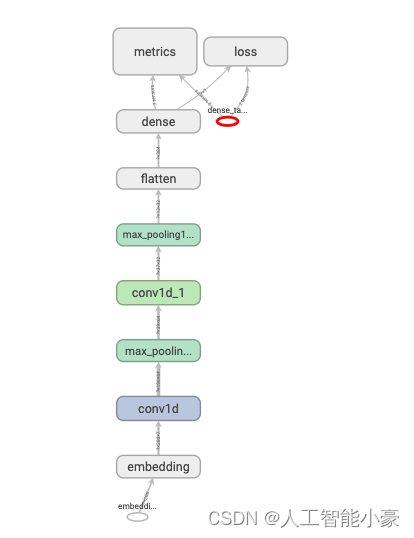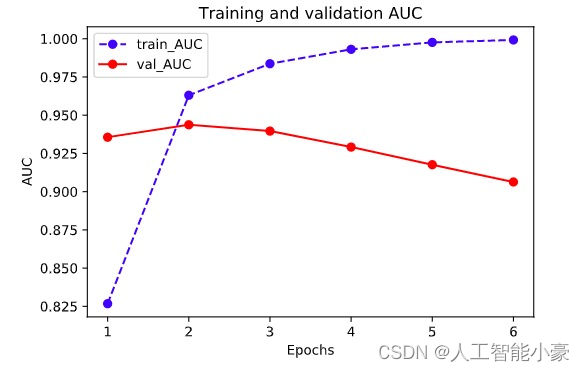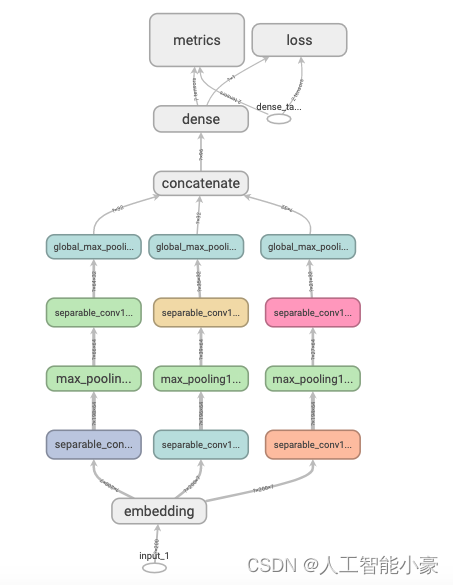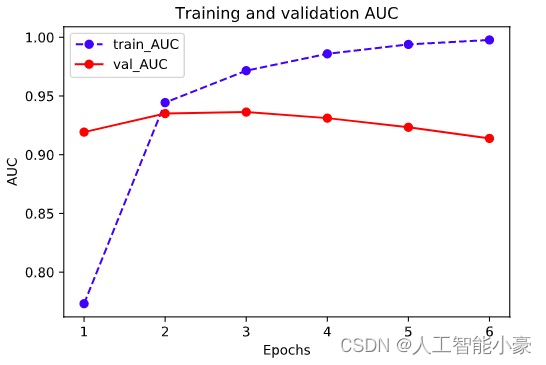TensorFlow模型构建的案例(IMDB)
2023-12-25 15:01:01
TensorFlow 中提供了三种方式来构建模型:
- 使用 Sequential 按层顺序构建模型
- 使用函数式 API 构建任意结构模型
- 继承 Model 基类构建自定义模型
对于顺序结构的模型,优先使用 Sequential 方法构建。如果模型有多输入或者多输出,或者模型需要共享权重,或者模型具有残差连接等非顺序结构,推荐使用函数式 API 进行创建。如果无特定必要,尽可能避免使用 Model 子类化的方式构建模型,这种方式提供了极大的灵活性,但也有更大的概率出错。
案例:IMDB
import numpy as np
import pandas as pd
import tensorflow as tf
from tqdm import tqdm
from tensorflow.keras import *
train_token_path = "./data/imdb/train_token.csv"
test_token_path = "./data/imdb/test_token.csv"
MAX_WORDS = 10000 # We will only consider the top 10,000 words in the dataset
MAX_LEN = 200 # We will cut reviews after 200 words
BATCH_SIZE = 20
# 构建管道
def parse_line(line):
t = tf.strings.split(line,"\t")
label = tf.reshape(tf.cast(tf.strings.to_number(t[0]),tf.int32),(-1,))
features = tf.cast(tf.strings.to_number(tf.strings.split(t[1]," ")),tf.int32)
return (features,label)
ds_train= tf.data.TextLineDataset(filenames = [train_token_path]) \
.map(parse_line,num_parallel_calls = tf.data.experimental.AUTOTUNE) \
.shuffle(buffer_size = 1000).batch(BATCH_SIZE) \
.prefetch(tf.data.experimental.AUTOTUNE)
ds_test= tf.data.TextLineDataset(filenames = [test_token_path]) \
.map(parse_line,num_parallel_calls = tf.data.experimental.AUTOTUNE) \
.shuffle(buffer_size = 1000).batch(BATCH_SIZE) \
.prefetch(tf.data.experimental.AUTOTUNE)Sequential 按层顺序创建模型
tf.keras.backend.clear_session()
model = models.Sequential()
model.add(layers.Embedding(MAX_WORDS,7,input_length=MAX_LEN))
model.add(layers.Conv1D(filters = 64,kernel_size = 5,activation = "relu"))
model.add(layers.MaxPool1D(2))
model.add(layers.Conv1D(filters = 32,kernel_size = 3,activation = "relu"))
model.add(layers.MaxPool1D(2))
model.add(layers.Flatten())
model.add(layers.Dense(1,activation = "sigmoid"))
model.compile(optimizer='Nadam',
loss='binary_crossentropy',
metrics=['accuracy',"AUC"])
model.summary()
import datetime
import matplotlib.pyplot as plt
baselogger = callbacks.BaseLogger(stateful_metrics=["AUC"])
logdir = "./data/keras_model/" + datetime.datetime.now().strftime("%Y%m%d-%H%M%S")
tensorboard_callback = tf.keras.callbacks.TensorBoard(logdir, histogram_freq=1)
history = model.fit(ds_train,validation_data = ds_test,
epochs = 6,callbacks=[baselogger,tensorboard_callback])
%matplotlib inline
%config InlineBackend.figure_format = 'svg'
def plot_metric(history, metric):
train_metrics = history.history[metric]
val_metrics = history.history['val_'+metric]
epochs = range(1, len(train_metrics) + 1)
plt.plot(epochs, train_metrics, 'bo--')
plt.plot(epochs, val_metrics, 'ro-')
plt.title('Training and validation '+ metric)
plt.xlabel("Epochs")
plt.ylabel(metric)
plt.legend(["train_"+metric, 'val_'+metric])
plt.show()
plot_metric(history,"AUC")
函数式 API 创建任意结构模型
tf.keras.backend.clear_session()
inputs = layers.Input(shape=[MAX_LEN])
x = layers.Embedding(MAX_WORDS,7)(inputs)
branch1 = layers.SeparableConv1D(64,3,activation="relu")(x)
branch1 = layers.MaxPool1D(3)(branch1)
branch1 = layers.SeparableConv1D(32,3,activation="relu")(branch1)
branch1 = layers.GlobalMaxPool1D()(branch1)
branch2 = layers.SeparableConv1D(64,5,activation="relu")(x)
branch2 = layers.MaxPool1D(5)(branch2)
branch2 = layers.SeparableConv1D(32,5,activation="relu")(branch2)
branch2 = layers.GlobalMaxPool1D()(branch2)
branch3 = layers.SeparableConv1D(64,7,activation="relu")(x)
branch3 = layers.MaxPool1D(7)(branch3)
branch3 = layers.SeparableConv1D(32,7,activation="relu")(branch3)
branch3 = layers.GlobalMaxPool1D()(branch3)
concat = layers.Concatenate()([branch1,branch2,branch3])
outputs = layers.Dense(1,activation = "sigmoid")(concat)
model = models.Model(inputs = inputs,outputs = outputs)
model.compile(optimizer='Nadam',
loss='binary_crossentropy',
metrics=['accuracy',"AUC"])
model.summary()Model: "model"
__________________________________________________________________________________________________
Layer (type) Output Shape Param # Connected to
==================================================================================================
input_1 (InputLayer) [(None, 200)] 0
__________________________________________________________________________________________________
embedding (Embedding) (None, 200, 7) 70000 input_1[0][0]
__________________________________________________________________________________________________
separable_conv1d (SeparableConv (None, 198, 64) 533 embedding[0][0]
__________________________________________________________________________________________________
separable_conv1d_2 (SeparableCo (None, 196, 64) 547 embedding[0][0]
__________________________________________________________________________________________________
separable_conv1d_4 (SeparableCo (None, 194, 64) 561 embedding[0][0]
__________________________________________________________________________________________________
max_pooling1d (MaxPooling1D) (None, 66, 64) 0 separable_conv1d[0][0]
__________________________________________________________________________________________________
max_pooling1d_1 (MaxPooling1D) (None, 39, 64) 0 separable_conv1d_2[0][0]
__________________________________________________________________________________________________
max_pooling1d_2 (MaxPooling1D) (None, 27, 64) 0 separable_conv1d_4[0][0]
__________________________________________________________________________________________________
separable_conv1d_1 (SeparableCo (None, 64, 32) 2272 max_pooling1d[0][0]
__________________________________________________________________________________________________
separable_conv1d_3 (SeparableCo (None, 35, 32) 2400 max_pooling1d_1[0][0]
__________________________________________________________________________________________________
separable_conv1d_5 (SeparableCo (None, 21, 32) 2528 max_pooling1d_2[0][0]
__________________________________________________________________________________________________
global_max_pooling1d (GlobalMax (None, 32) 0 separable_conv1d_1[0][0]
__________________________________________________________________________________________________
global_max_pooling1d_1 (GlobalM (None, 32) 0 separable_conv1d_3[0][0]
__________________________________________________________________________________________________
global_max_pooling1d_2 (GlobalM (None, 32) 0 separable_conv1d_5[0][0]
__________________________________________________________________________________________________
concatenate (Concatenate) (None, 96) 0 global_max_pooling1d[0][0]
global_max_pooling1d_1[0][0]
global_max_pooling1d_2[0][0]
__________________________________________________________________________________________________
dense (Dense) (None, 1) 97 concatenate[0][0]
==================================================================================================
Total params: 78,938
Trainable params: 78,938
Non-trainable params: 0
__________________________________________________________________________________________________
import datetime
logdir = "./data/keras_model/" + datetime.datetime.now().strftime("%Y%m%d-%H%M%S")
tensorboard_callback = tf.keras.callbacks.TensorBoard(logdir, histogram_freq=1)
history = model.fit(ds_train,validation_data = ds_test,epochs = 6,callbacks=[tensorboard_callback])
plot_metric(history,"AUC")
Model 子类化创建自定义模型
# 先自定义一个残差模块,为自定义Layer
class ResBlock(layers.Layer):
def __init__(self, kernel_size, **kwargs):
super(ResBlock, self).__init__(**kwargs)
self.kernel_size = kernel_size
def build(self,input_shape):
self.conv1 = layers.Conv1D(filters=64,kernel_size=self.kernel_size,
activation = "relu",padding="same")
self.conv2 = layers.Conv1D(filters=32,kernel_size=self.kernel_size,
activation = "relu",padding="same")
self.conv3 = layers.Conv1D(filters=input_shape[-1],
kernel_size=self.kernel_size,activation = "relu",padding="same")
self.maxpool = layers.MaxPool1D(2)
super(ResBlock,self).build(input_shape) # 相当于设置self.built = True
def call(self, inputs):
x = self.conv1(inputs)
x = self.conv2(x)
x = self.conv3(x)
x = layers.Add()([inputs,x])
x = self.maxpool(x)
return x
#如果要让自定义的Layer通过Functional API 组合成模型时可以序列化,需要自定义get_config方法。
def get_config(self):
config = super(ResBlock, self).get_config()
config.update({'kernel_size': self.kernel_size})
return config
# 测试ResBlock
resblock = ResBlock(kernel_size = 3)
resblock.build(input_shape = (None,200,7))
resblock.compute_output_shape(input_shape=(None,200,7))
TensorShape([None, 100, 7])
# 自定义模型,实际上也可以使用Sequential或者FunctionalAPI
class ImdbModel(models.Model):
def __init__(self):
super(ImdbModel, self).__init__()
def build(self,input_shape):
self.embedding = layers.Embedding(MAX_WORDS,7)
self.block1 = ResBlock(7)
self.block2 = ResBlock(5)
self.dense = layers.Dense(1,activation = "sigmoid")
super(ImdbModel,self).build(input_shape)
def call(self, x):
x = self.embedding(x)
x = self.block1(x)
x = self.block2(x)
x = layers.Flatten()(x)
x = self.dense(x)
return(x)
tf.keras.backend.clear_session()
model = ImdbModel()
model.build(input_shape =(None,200))
model.summary()
model.compile(optimizer='Nadam',
loss='binary_crossentropy',
metrics=['accuracy',"AUC"])以上是TensorFlow 中搭建模型的三种案例与代码,希望对你有所帮助,同时模型的搭建也是学习TensorFlow中非常重要的一部分。
文章来源:https://blog.csdn.net/2301_81888214/article/details/135197919
本文来自互联网用户投稿,该文观点仅代表作者本人,不代表本站立场。本站仅提供信息存储空间服务,不拥有所有权,不承担相关法律责任。 如若内容造成侵权/违法违规/事实不符,请联系我的编程经验分享网邮箱:veading@qq.com进行投诉反馈,一经查实,立即删除!
本文来自互联网用户投稿,该文观点仅代表作者本人,不代表本站立场。本站仅提供信息存储空间服务,不拥有所有权,不承担相关法律责任。 如若内容造成侵权/违法违规/事实不符,请联系我的编程经验分享网邮箱:veading@qq.com进行投诉反馈,一经查实,立即删除!